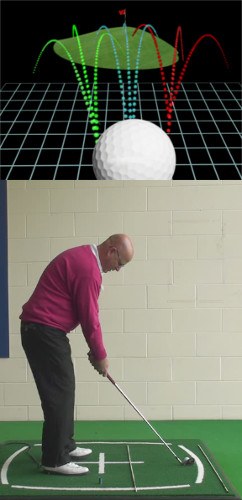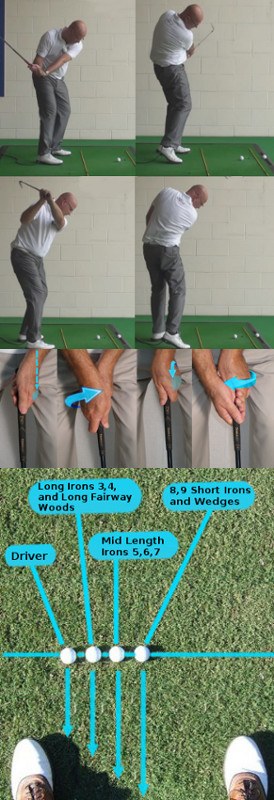One of the great thrills in golf is shaping a shot just right in order to access a difficult hole location.

Shaping shots is a skill that many amateur golfers feel is out of reach, but that doesn’t need to be the case. If you are willing to work on the fundamentals of your game, and spend some time experimenting on the range, you might find that shaping shots is something you can add to your repertoire. It’s not easy, of course, but nothing in golf is easy. Those who are willing to put in the work may be rewarded with a skill that can save countless shots for years to come.
The nice thing about learning the skill of shaping your shots is that you don’t have to commit to any big change that is going to set you back on the course. For example, if you decide to change some basic fundamental element of your swing, you might get worse on the course before you get better. That doesn’t need to be the case here. You can keep playing your same game while working on adding new shots during practice. Only when you are confident that those shots can be trusted should you test them out on the links.
To get started, simply carve out a few minutes during each practice session for working on shaped shots. Usually, that will mean attempting to curve the ball in a direction opposite to what you do with your standard swing. So, if you are a draw player naturally, spend a few minutes trying to hit fades. You might not be very successful at first, but that’s okay – just spend a few minutes trying, and move on. As time goes by, you’ll hopefully notice that you are having more and more success, and you may get to a point where you are willing to try out your new shot on the course.
In this article, we are going to offer some advice on how to shape your shots. Some of this advice will be physical in nature, and some will relate to the mental side of the game. Also, all of the instruction that follows has been written from the perspective of a right-handed golfer. If you happen to play left-handed, please review the directions as necessary.
Understanding Why Shots Curve

As a golfer, you already know that it is virtually impossible to hit a straight shot. Even shots that fly mostly straight tend to have a little bit of a curve in one direction or the other. Rather than trying to hit the ball perfectly straight – and inevitably failing – it is a better idea to plan on curving the ball in toward your target. Which way you curve it, and how much, is something that you will have to work on in practice.
To back up for a moment, we first should explain exactly why the ball is curving in the air. Why is it so hard – nearly impossible – to hit a perfectly straight shot? What is it that decides whether the ball will turn right or left as it flies? This all might seem pretty complicated, but it’s relatively straightforward once you understand the basics. We hope the points listed below will help you grasp the concepts at play here.
Okay – so we now know that face angle and swing path are the major determining factors in shot shape. But how do they come together to decide which way your shots are going to fly. Well, for starters, if you swing straight down the line with a square club face, that shot is going to fly straight through the air. As we’ve mentioned above, that doesn’t happen very often – even for the best golfers – but it’s technically possible.
More likely, your ball is going to curve to the right or the left, and that will be determined by the angle of the face relative to the path. In other words, if the club face is open as compared to the path that you are using as you swing through the ball, the shot will fade to the right. On the other hand, if the face is closed compared to the swing path, the ball will draw to the left. This is a complicated game, but it really is that simple with regard to ball flight.
It’s important to understand that the severity of the curve on your shots will be determined by how open or closed the clubface is at the moment of impact. If the face is just slightly open, for instance, a soft fade will be the result. However, if the face is wide open, a wild slice is sure to follow. The same can be said for turning the ball left. With the face just a little closed, you’ll hit a draw. Close it too much, on the other hand, and a nasty hook is going to be your reward.
Some Suggestions

We hope that you now have a basic understanding of how golf works in terms of what variables have an effect on the shot shapes you produce. At this point, we are going to move on to offer some advice on how you can get started in an effort to hit new types of shots. For this section, we are going to assume that you currently have a ‘standard’ ball flight which shows itself on most of your swings. Most golfers – assuming they have at least a little bit of experience – know which way most of their shots will turn. You might be a fade player, or you may be a draw player, but you probably aren’t both. Everyone hits a surprising shot from time to time, but the prevailing pattern in your game should be obvious. If it isn’t, keep working on your technique until you have a steady ball flight pattern. Once that happens, then get to work on developing different shot shapes.
The list below includes some tips to keep in mind if you try to shape some shots during your next visit to the driving range.
The list above probably looks pretty simple. There are only three points listed, and none of them are exactly groundbreaking to the experienced golfer. Things like stance, grip, and ball position are core fundamentals in the game. However, as you start to experiment in practice and you get into the process of hitting new shots, you’ll see that things can quickly get rather complicated. The way all of these changes interact with one another, and how your swing reacts when you start making changes, is going to take time to figure out. Like everything in golf, progress will likely come slow at first, but it will feel quite rewarding when you start to turn the corner and see some excellent outcomes.
The Process of Practice

Many golfers – too many, in fact – don’t seem to understand the idea of practicing this game. For some reason, golfers like to practice the things they already do well. If you are good with your driver, you probably spend a lot of time on the range hitting drivers. But why? You’ve already got that part of the game under control – work on one of your weaknesses! Sure, you need to maintain your strengths, but those areas don’t need as much attention as the parts of your game that consistently give you trouble.
This same concept can be applied to working on new shot shapes. If you are already comfortable with your draw, for example, you should take some time to work on other shots that could help you on the course. Are those shots going to look great right off the bat and impress everyone on the range? Probably not. You’ll hit some ugly ones, and there will be some frustrating moments along the way. The willingness to going through those struggles is what separates golfers who never improve from those who eventually reach their goals.
During your next range session, make it a goal to hit 10 shots where you work on carving the ball in the opposite direction to what you do normally. That isn’t very many shots, but it is a great starting point. Usually hit a fade? Try hitting 10 draws with a variety of clubs and see how you do. It might be that you don’t succeed on a single one, and that’s okay. In this case, it really is the effort that counts. As you continue to work on shot shapes that don’t necessarily come naturally to you, your overall game should improve, and you’ll start to see many more possibilities out on the course.
In order to improve at golf, you need to be willing to fail. You need to be willing to hit bad shots on the driving range until you figure out the mechanics to hit better ones. You need to be willing to hit some ugly shots on the course as you build trust in your new shot shapes. If you are only willing to stick with what is comfortable, there is no way you’ll improve. By giving yourself a chance to develop some new shot shapes, you might surprise yourself and learn that you are capable of more on the course than you ever thought possible.
The Value of Shaping Shots for Seniors

Make no mistake – shaping shots is a skill that can help golfers of all ages. Golf courses present a variety of challenges to players, so having as many shots as possible in the bag will help you make it from the first tee to the final green. With that said, it may be true that senior golfers can benefit even more than younger players when they add the ability to produce new shot shapes.
While there are always exceptions, senior golfers tend to struggle with two specific things – lost distance and an inability to hit the ball high in the air. If that sounds like your game currently, learning how to shape the ball may be exactly the step you need to take. Why? Let’s take a look –
Learning how to shape shots is not only good for your game as a whole, it is also a lot of fun. Golf can get a bit stale if you hit the same shots over and over again, so take on the challenge of learning how to shape shots in order to strive for lower scores and to enjoy yourself along the way. Good luck!





